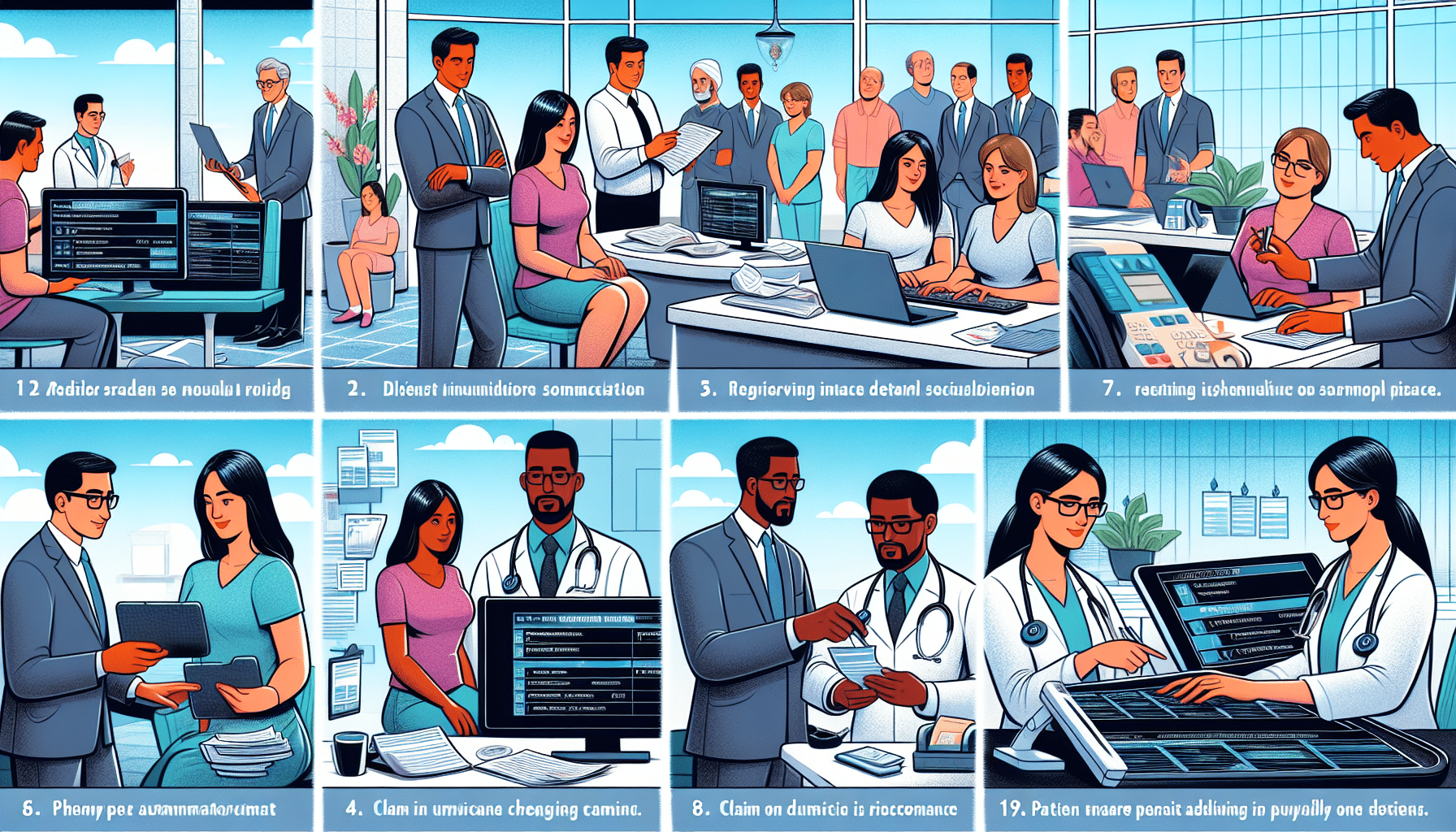The medical billing process is essential for healthcare providers to receive payment for services rendered. In this article, we’ll break down each step of this process, from patient registration, insurance verification, coding of services, claim submission, to handling denials and appeals.
It’s designed to offer you, whether you are a healthcare professional or a curious reader, a practical overview without overwhelming detail. Let’s navigate these crucial stages together.
What Is Medical Billing?
Medical billing and coding is a sophisticated dance between healthcare providers and insurers, where the rhythm is set by the methodical generation of healthcare claims. Imagine this as a performance where every step counts; a single misstep, a misaligned beat, and the dance falters, potentially leading to significant financial instability for healthcare practices and dissatisfaction among patients.
This delicate balance is where medical billers shine, translating the language of medical care into a symphony of codes and figures, ensuring that the providers are properly reimbursed for their invaluable medical services rendered. Outsourced billing services can further enhance this process by providing specialized expertise and efficiency.
The narrative of medical billing is not without its challenges, as errors within this intricate process can cascade into a torrent of revenue losses and administrative burdens. To mitigate this, the opening act of patient registration is pivotal.
Here, a file is established, becoming the foundation upon which the entire billing cycle is built. It is a moment where clarity must reign supreme, ensuring patients are well-informed of their financial responsibilities, thereby fostering timely collections and setting a positive tone for the journey ahead.
The Medical Billing Workflow

Embark on an exploration of the medical billing cycle, a carefully constructed series of steps that connects healthcare services with financial reimbursement. Every stage, beginning with patient registration and culminating in the crucial task of handling patient payments, plays an essential role in enhancing the revenue cycles for healthcare providers.
As we unfold this story, let us investigate its core elements to understand how technological advancements and efficiency amalgamate to facilitate a smooth transactional experience within the realm of medical billing.
Initiating Patient Registration
As the curtain of patient care rises, we begin with the crucial step of registering patients, where we meticulously record their demographic data and health insurance specifics. This initial interaction is fundamental to laying a solid foundation for managing financial elements throughout the medical journey.
It establishes clarity around eligibility and benefits right from the start. The careful collection of demographics isn’t just routine—it’s essential as it lights up the path that leads to an efficient billing process.
The healthcare odyssey then proceeds with a judicious approach—obtaining payments such as co-pays directly at service time. This strategy extends beyond mere fiscal wisdom. Its aim is also to alleviate some heavy administrative burdens plaguing healthcare facilities.
By garnering part of these funds early on, tasks like pursuing outstanding patient balances and reconciling accounts become more manageable endeavors—the ripple effect simplifies every episode in this financial narrative while reinforcing fiscal accountability.
Amidst all activities within a bustling medical office stands check-in—a pivotal phase during which pertinent forms are either updated or filled out anew, including comprehensive documentation of medical history records, paired with precise capture of co-payments when due.
At this intersection lies one vital piece in assembling complete registration prior to any forthcoming clinical encounter—an encounter whose details will soon be translated into codes for successful navigation through billing waters ahead.
Verification of Insurance Coverage
As we advance in our process, the verification of insurance coverage emerges as a pivotal step that demands meticulous attention and accuracy. During this stage, it’s not merely about gathering the patient’s insurance details but meticulously examining them through direct engagement with their insurer to confirm an array of key factors including benefits, effective dates of coverage, and specifics related to the health plan involved.
This critical juncture establishes what costs will be borne by both provider and patient while clarifying which medical procedures and services are likely to be sanctioned by insurers.
The fabric of insurance coverage is intrinsically complex, casting a significant shadow over our billing tale. The narratives woven from deductibles, copayments, and even supplemental gap insurances demand careful untangling.
Each component needs thorough inspection so we can fully comprehend every aspect contributing to patients’ financial commitments. Traversing this labyrinth requires skill—a skillful unraveling of company-specific policies intertwined with intricate layers of coverages.
In a recurrent scenario that compels perpetual alertness among medical billers—the unchanging yet challenging task—is re-confirming existing clients’ information prior to each visitation irrespective of their regularity within your walls ensures current data protection against inefficiencies prone errors potentially leading towards refuted claims safeguarding thus smooth traversal throughout all phases incorporated within the reimbursement cycle without disruptions caused due unexpected adjustments found lingering amidst ever-evolving arenas pertaining various individuals’ indemnifications.
From Encounter to Claim Submission
The conversion from detailed notes taken during a patient encounter into diagnostic and procedural codes is an artfully executed by medical coders. The precision of these medical codes shapes the storyline for each claim, ultimately influencing the reimbursement outcome.
This transformation culminates in a superbill that combines all pertinent patient data with services rendered and their relevant codes. Patient statements subsequently reflect this essential coding process.
Creating a medical claim resembles drawing up an intricate itinerary, tracing the route from performed healthcare services to financial remuneration. A medical biller ensures compliance with rigorous standards of both payer requirements and accurate medical records as they prepare claims for submission through Electronic Data Interchange (EDI), smoothing out its transit toward payers.
Prior to dispatching on its journey towards adjudication, every claim must pass thorough verification via scrubbing procedures aimed at verifying its accuracy and fullness—ensuring it’s fit for passage. Once validated, claims navigate either directly or through clearinghouses to reach major payers like Medicaid—an indispensable step crucial to prompt processing of submitted claims within the realm of health care transactions.
Understanding Payer Adjudication
The realm of payer adjudication is where claims face their ultimate fate, a decision-making coliseum where the liability of insurance companies is weighed and measured. Here, the adjudication process unfolds, scrutinizing each claim with a discerning eye, contrasting patient information, clinical data, and billing codes against the backdrop of policy specifications.
It is a domain where precision is paramount, as the slightest divergence can alter the outcome, impacting payment timelines and the financial wellbeing of providers.
Complex and fraught with potential errors, the adjudication process can stretch over weeks, each case a puzzle that must be pieced together to reveal whether the claim will be fully paid, partially settled, or denied. In instances where clarity is lacking, and claims hang in the balance as ‘pending’, additional information becomes the key to unlocking their resolution.
This intricate dance of adjudication is a testament to the multifaceted nature of medical billing, where each decision echoes through the financial corridors of healthcare providers.
The Outcome of Adjudication
Each resolution in payer adjudication is distinct, much like the claims themselves, with every outcome telling a unique part of the billing narrative. When a claim is accepted, it signifies that it has navigated successfully through the adjudication process and there exists a concordance between provider and insurer on its validity. This acceptance acts as an indicator of impending financial remuneration for services provided.
In contrast stands the denied claim—a story marked by disapproval wherein the payer concludes that payment cannot be issued based on various detailed justifications found within the remittance advice. Such denial marks a complex juncture where providers must dissect intricate codes and justifications to carve out avenues towards potential payment recovery.
Rejections are not necessarily final. Often they suggest either a need for additional information or rectification—providing opportunities for redressal leading potentially to the ultimate acknowledgment of the claim.
Navigating Denials and Appeals
The journey of medical billing often traverses the turbulent waters of denied claims, where a plethora of complications such as overlooked deadlines for submission, absence of required pre-authorization, and errors in coding can overturn even meticulously prepared submissions.
These denials are not just mere obstacles. They represent critical junctures that require a methodical approach. Denial management steps in to steer through this process with an analytical eye and corrective measures aimed at preempting instances.
Equipped with detailed metrics on performance and enhanced processes, denial management turns these trials into chances for improvement. Each rejected claim serves as an instructive case study leading to more efficient handling practices and subsequent revenue increases by mitigating repeat rejections.
This refined strategy calls for collaborative synergy among various sectors working harmoniously to diminish occurrences of denials while bolstering financial flow.
Instruction plays a beacon role in navigating this course effectively, ensuring that those involved in the revenue cycle are well-informed about insurance protocols along with tactics designed to prevent denials from happening initially.
With claims rejection rates potentially escalating annually by up to 15%, it becomes imperative continuously scrutinize trends related to denials so as adjust strategies accordingly within denial management practices regularly—a realm where persistent vigilance coupled with flexibility is highly valued.
Innovations Shaping the Future of Medical Billing
Looking ahead, the field of medical billing is undergoing significant changes that are set to enhance its effectiveness, precision, and security. At the helm of this evolution is artificial intelligence, which offers transformative automation capabilities for administrative duties and elevates the accuracy of submitting medical bills to unprecedented levels.
This surge in automated technology also improves coding practices and eligibility checks, making the entire billing process more efficient through rapidity and exactness.
In this dynamic period of change, data analytics emerges as a crucial navigator driving policy improvement towards a standardized adjudication process that is both effective and uniform. The focus during these times extends beyond mere figures and nomenclature. It encompasses applying analytical insight to refine approaches while exerting influence on policymaking decisions aimed at optimization.
Patients stand at the heart of these advancements with patient-focused billing solutions highlighting transparency in processes including digital payment systems and online account administration – all designed for their ease within an increasingly streamlined healthcare encounter.
Blockchain’s introduction into medical billing brings an increased degree of safety regarding data integrity along with heightened visibility throughout every step of the process. Cybersecurity too has gained importance—standing vigilant over sensitive information—and ensuring strict adherence to legal standards safeguarding privacy rights against potential breaches.
Collectively, these leaps forward constitute not simple enhancements, but rather profound developments poised to shape what lies ahead for medical billing practices globally.
Summary
In the intricate ballet of medical billing, each step from patient registration to final reimbursement is a testament to the resilience and adaptability of healthcare providers. The journey through the medical billing workflow, payer adjudication, denial management, and the embrace of innovations spotlights a process that is continually evolving.
As the curtain falls, we are left with a sense of admiration for the professionals who navigate this complex landscape and anticipation for a future where medical billing is not just a function, but a beacon of efficiency and patient empowerment.
Frequently Asked Questions
What is medical billing?
Medical billing entails the preparation of healthcare claims that are submitted to insurance companies, which is a crucial process for securing accurate compensation for medical services rendered.
Why is patient registration important in medical billing?
In medical billing, patient registration is crucial as it gathers essential demographic and insurance information to facilitate smooth billing processes while also assessing the patient’s eligibility and financial obligations.
How can healthcare providers manage claim denials more effectively?
Healthcare providers can enhance their approach to dealing with claim denials by adopting strategic denial management processes. This involves scrutinizing the underlying causes of rejections, implementing corrective actions to remedy and avert subsequent denials, as well as providing training for personnel on insurance policies and billing procedures.
What happens during payer adjudication?
During the process of payer adjudication, the insurance company evaluates the submitted claim to ascertain its obligation for payment, considering patient details, clinical evidence, and billing identifiers.
What innovations are shaping the future of medical billing?
The medical billing process is being revolutionized by advancements such as artificial intelligence, automation, data analytics, blockchain technology, and enhanced cybersecurity. A focus on patient-centric billing practices is contributing to increased precision, efficiency and the safeguarding of sensitive information within this domain.


